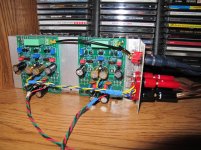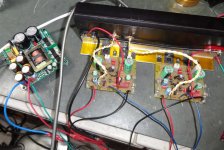I think two questions arise about the ccs:
1. If we assume a really good PSU, does VSSA really need any kind of ccs to the optimal sonic performance? Shaan's answer is clear no. He used ccs in an experimental version of PeeCeeBee (not mentioned what type used) and the result described as "something strange" or "clinical" His opinion is that vssa sings perfect without ccs, and the music appears to be free of any limitation. Lazy Cat has totally opposite experience: the difference is like "day and night" benefit of ccs.
2. If yes it is not so clear to me, what is the correlation between the applied ccs and the sonic quality. Theoretically 2 Q's ccs is better than any other in respect of thermal stability, accuracy of FB, lower THD, etc.(see Rod Elliott's article e.g.) and very close the ideal constant current source though some builders found that bjt+led work better with this topology as ivanlukic mentioned above. How these collerate to the listening impressions. Has anyone experience with other type ccs, like TL431?
Thanks
egra
Hi egra
The question is who do you believe more.
1. My clear answer is the same as it was. There's not only one reason to go with CCS.
2. 2Q CCS is the worst among the others, again for more than one reason.
You're free to experiment, measure and listen, which is exactly what I did.
Hi Andrej!
Thank You for your answers. Finally I believe my ears of course, but the considerations of experienced designers are also important for me. Someone said that amplifier design isn't a rocket science, but seems it is more than engineering challenge, somewhere between art and science. I like the "avenue", where Jason is walking.
Cheers
egra
Thank You for your answers. Finally I believe my ears of course, but the considerations of experienced designers are also important for me. Someone said that amplifier design isn't a rocket science, but seems it is more than engineering challenge, somewhere between art and science. I like the "avenue", where Jason is walking.
Cheers
egra
Come on in! The water is fine...
OK folks, I just had a truly proper listen to my latest version of the VSSA and am quite pleased with it. I'd suggest that no one get stressed about the 2Q CCS, it sounds just fine. If a 1Q+LED CCS is truly superior then that can be left for a future revision. A pic attached of the stereo 'test rig'. It is just running on a CRC supply, not pictured.
For those with these boards my recommendation is just to build them to the published schematic that goes with this variant to ensure they work first shot. If you so desire, tweak them later. Hope to hear of a few more reaching their marks soon.
OK folks, I just had a truly proper listen to my latest version of the VSSA and am quite pleased with it. I'd suggest that no one get stressed about the 2Q CCS, it sounds just fine. If a 1Q+LED CCS is truly superior then that can be left for a future revision. A pic attached of the stereo 'test rig'. It is just running on a CRC supply, not pictured.
For those with these boards my recommendation is just to build them to the published schematic that goes with this variant to ensure they work first shot. If you so desire, tweak them later. Hope to hear of a few more reaching their marks soon.
Attachments
If a 1Q+LED CCS is truly superior then that can be left for a future revision.
Jason, please do not understand me wrong, I never said 1Q+LED CCS is good, because it is not, especially for this purpose. VSSA and specifically First One has very different type of CCS.

Congratulations on a nice build. We should spread VSSA worldwide and promote this simple CFA wherever is possible.

Looks good Jason. I'm just waiting on some caps and trimmers and mine will be done. Mounted them on a heatsink today. Looking forward to the listening test. In honor of this build I listened to both VSSA's today, yours and Pete's. They are virtuously identical in sound. They are both powered by identical power supplies. I'm planning to power this with a Connex SMPS to see if I can hear a difference. Can't wait.
Blessings, Terry
Blessings, Terry
Jason, please do not understand me wrong, I never said 1Q+LED CCS is good, because it is not, especially for this purpose. VSSA and specifically First One has very different type of CCS.
Congratulations on a nice build. We should spread VSSA worldwide and promote this simple CFA wherever is possible.
Thanks LC.
I was not suggesting you said to use a specific CCS type, but others did. I simply chose what I thought would serve the purpose and be based on BJTs. I have little experience with JFETs as some like to use, so I tend to avoid them. And no, lack of experience isn't a valid reason the steer clear of FETs. Of the basic BJT CCS types the 2Q seemed to fit the bill so there it is.
Care to give a peek at what you feel is the most suitable CCS for the VSSA, assuming it isn't secret IP?
Looks good Jason. I'm just waiting on some caps and trimmers and mine will be done. Mounted them on a heatsink today. Looking forward to the listening test. In honor of this build I listened to both VSSA's today, yours and Pete's. They are virtuously identical in sound. They are both powered by identical power supplies. I'm planning to power this with a Connex SMPS to see if I can hear a difference. Can't wait.
Blessings, Terry
How did you find working with these boards? They seem to solder up nice and don't seem overly tight to me. I'll assume you got everything lined up fairly easily. Just looking even for some basic feedback on ease of construction for now.
I think they are nice. The only thing I thought might be better would be larger solder pads for the FASTON connectors. Why is your input cap so big? Most of the other versions used a smallish electro.
Good feedback. The size of cap is a holdover from caps I had on hand and I just stayed with that size. I should make for alternative spacings to accommodate different capacitor choices. I'm sure there is nothing wrong with an electrolytic, but I seem to migrate towards film.
Last edited:
Hey Jason,
What rails are you planning to use? I just remembered that I built PMI's version for higher rails but never tried it. I have a bigger transformer now maybe I'll give it a try.
When I get to a proper 'production' PSU I'm looking to operate at the +/-40V to +/-45 mark. The devices will tolerate higher supplies but on a single pair of outputs I would suggest keeping the supply to not more than +/-50V. Going too high may risk output transistor failure, especially with 4Ω speakers or speakers that have significant impedance dips.
Best to remember this is a smallish amplifier and it has some really nice attributes but we must be aware of its limitations too.
Yeah, just wondering. I had a bunch of 25-0-25 transformers so a lot of the amps I built since I have been back were all using +-37V rails. On Pete's boards I used BC546/547's for the input pair intending to try it at higher rails to see if there was a noticeable difference in sound but never got around to trying it. I recently bought a 34-0-34vac transformer for an nx amp I'm building so I have it available right now. I did set up the Cap multiplier in Pete's amp for higher rails too so maybe I'll pop the top and hook up the bigger transformer and see if I can hear anything interesting.
I am contemplating using an SMPS with your boards. Is there anything you can think of that I should watch out for? I know the SMPS is instant on. See any problems with that?
Thanks, Terry
I am contemplating using an SMPS with your boards. Is there anything you can think of that I should watch out for? I know the SMPS is instant on. See any problems with that?
Thanks, Terry
still4given said:I am contemplating using an SMPS with your boards. Is there anything you can think of that I should watch out for? I know the SMPS is instant on. See any problems with that?
Thanks, Terry
Nothing major, just make sure that R16 and R19 will take the inrush, perhaps even going to 1/2W or even 1W. Just bend the leads to stand a slightly bigger resistor a short ways off the board if desired. Note that this may not actually be an issue, just something to be aware of depending on how quick the SMPS rails are established. Not all are nearly instant, but many are.
Hey Jason,
My parts didn't come today so I took some time to play around with the SMPS. I hooked it up to an old Symasym I had laying around. Wow, it sounds stellar. I even A/B'd it against my other Symasym as well as the two VSSA's I have completed. I could not hear a difference. I'm not sure how it measures but it is very, very nice. The SMPS is 4" x 4" x 2" and weighs 9oz. I have a feeling there are going to be more of these in my future amps. I may even retrofit a few of the ones I have. For $70 shipped, you can't build a conventional PSU.
Blessings, Terry
My parts didn't come today so I took some time to play around with the SMPS. I hooked it up to an old Symasym I had laying around. Wow, it sounds stellar. I even A/B'd it against my other Symasym as well as the two VSSA's I have completed. I could not hear a difference. I'm not sure how it measures but it is very, very nice. The SMPS is 4" x 4" x 2" and weighs 9oz. I have a feeling there are going to be more of these in my future amps. I may even retrofit a few of the ones I have. For $70 shipped, you can't build a conventional PSU.
Blessings, Terry
Attachments
- Status
- This old topic is closed. If you want to reopen this topic, contact a moderator using the "Report Post" button.
- Home
- Amplifiers
- Solid State
- VSSA Through-Hole Version by Jason


